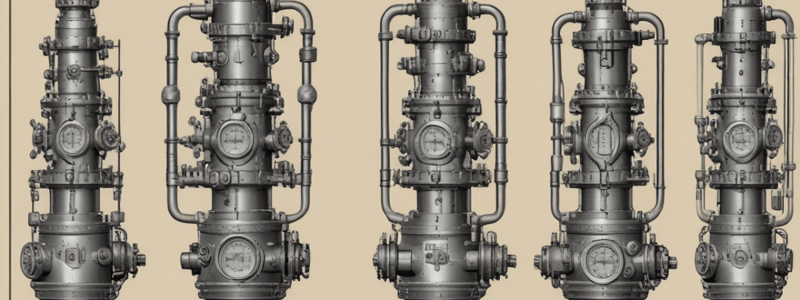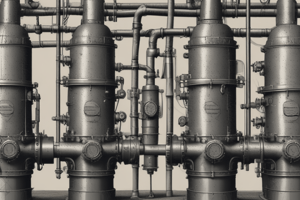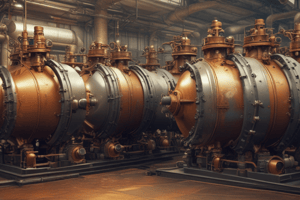Podcast
Questions and Answers
Match the following types of tests with their frequency:
Match the following types of tests with their frequency:
Try Lever Test = Monthly on steam heating boilers, every three months for hot water heating boilers, and every six months on power boilers Pop Test = Annually, before taking a boiler off-line for maintenance Accumulation Test = Not mentioned in the context Boiler Test = Not mentioned in the context
Match the following tests with their objectives:
Match the following tests with their objectives:
Try Lever Test = To determine if a pressure relief valve is operating freely Pop Test = To check the full operation of the safety valve, including the exact pressures at which it opens and closes Accumulation Test = Not mentioned in the context Boiler Test = Not mentioned in the context
Match the following boiler types with their pressure requirements for try lever tests:
Match the following boiler types with their pressure requirements for try lever tests:
Steam Heating Boiler = Pressure must be 35 kPa or higher Power Boiler = Pressure must be at least 75% of the setting of the safety valve Hot Water Heating Boiler = Not mentioned in the context High Pressure Boiler = Not mentioned in the context
Match the following procedures with their steps:
Match the following procedures with their steps:
Match the following valve conditions with their required actions:
Match the following valve conditions with their required actions:
Match the following test results with their implications:
Match the following test results with their implications:
Match the following codes with their relevant sections:
Match the following codes with their relevant sections:
Match the following tests with their purposes:
Match the following tests with their purposes:
Flashcards are hidden until you start studying
Study Notes
Pressure Relief Valve Maintenance
- Pressure relief valves must be kept in good working condition at all times and tested regularly to ensure proper functioning.
Try Lever Test
- The try lever test determines if a pressure relief valve is operating freely, but not if it will open at its set pressure.
- The test is performed:
- Monthly on steam heating boilers
- Every three months for hot water heating boilers
- Every six months on power boilers operating below 2760 kPa
- Prior to pop tests and accumulation tests
- Boiler pressure must be:
- 35 kPa or higher for steam heating boilers
- At least 75% of the safety valve setting for power boilers
- The test procedure:
- Pull the try lever to the wide-open position
- Allow steam to discharge for 5-10 seconds
- Release the lever
- Allow the spring to snap the valve disc to the closed position
- If the valve simmers, operate the try lever 2-3 times to allow the disc to seat properly
Pop Test
- The pop test checks the full operation of the safety valve, including the exact pressures at which it opens and closes.
- The test procedure:
- Increase the boiler steam pressure to the safety valve set point
- Record the opening and reseating pressures accurately
- Compare the opening pressure and blowdown to the ASME BPVC performance tolerances
- The pop test should be performed annually, before taking a boiler off-line for maintenance.
- Defective valves can be identified and replaced or repaired prior to the boiler re-entering service.
Repair and Adjustment
- Repair or adjustment of pressure relief valves must be done by the valve manufacturer or its authorized repair representative.
- Consult the relevant ASME BPVC sections and the local Boiler Inspector to determine who is qualified to adjust or repair PRVs in a particular jurisdiction.
Studying That Suits You
Use AI to generate personalized quizzes and flashcards to suit your learning preferences.




